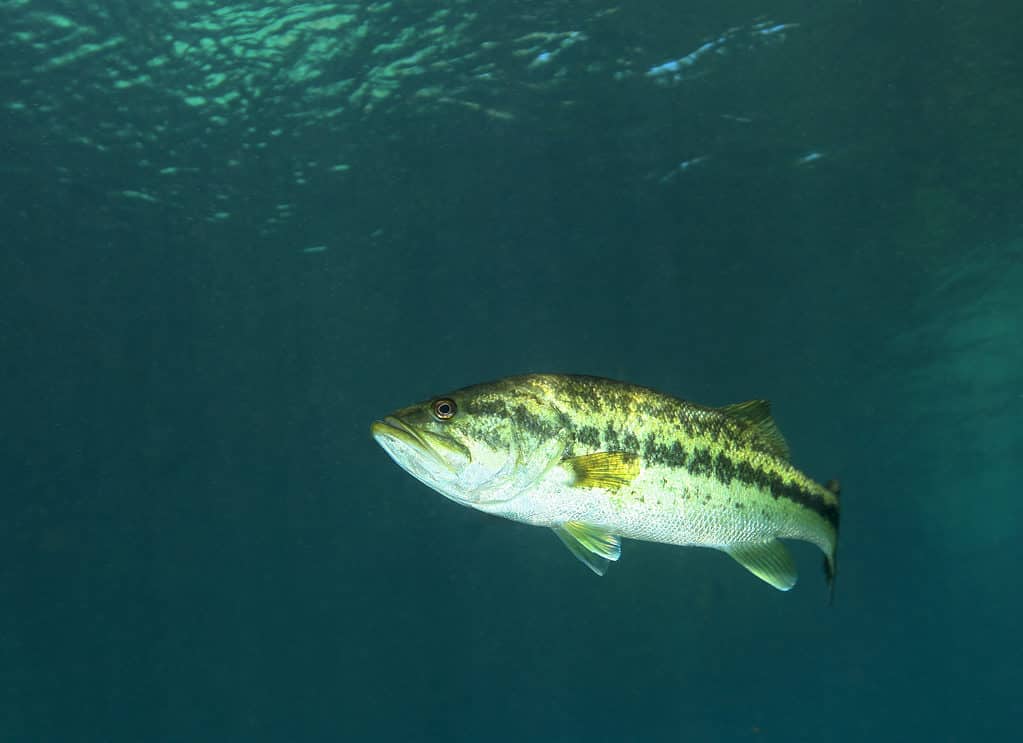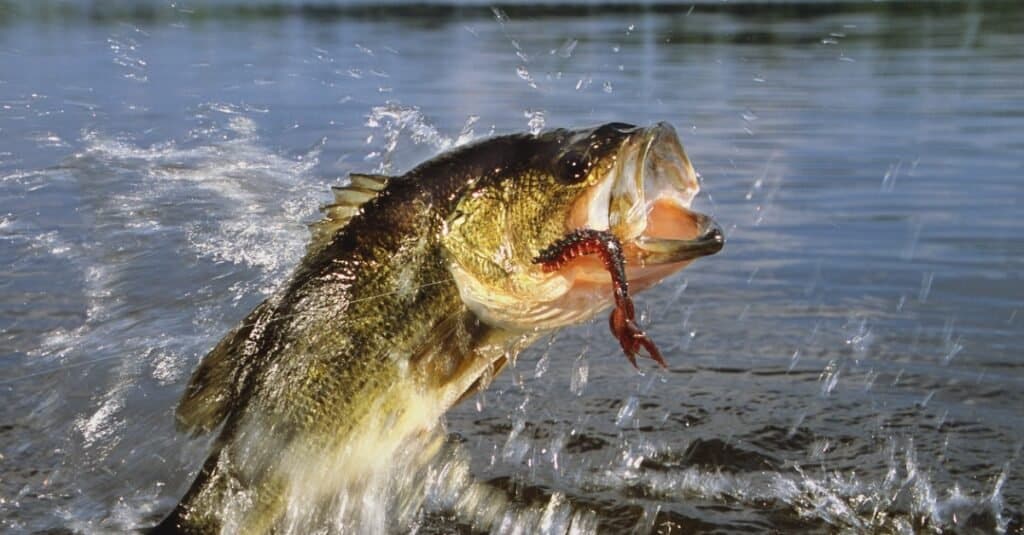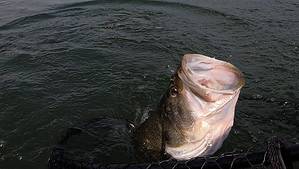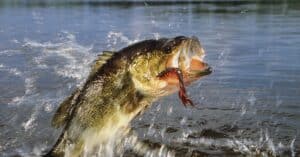As the saying goes, everything’s bigger in Texas, but is that also true for the state’s game fish? Bass fishing is certainly bigger than ever in the Lonestar State, and the Texas Parks and Wildlife Foundation conveniently tracks the state’s 50 largest largemouth bass ever caught. But we’re here to look at the fish that topped the list, as well as the skilled angler who managed to reel it in! Furthermore, we’ll also compare it to the largest largemouth ever caught in the world. Read on to learn all about this amazing state record – and some facts about the largemouth bass as a species while we’re at it!

Interesting Facts About the Largemouth Bass
Native to much of North America, the largemouth bass prefers warm, clear, slow-moving bodies of water with lots of aquatic plants. But it doesn’t need the plant cover to hide from predators! In fact, it’s a fully carnivorous apex predator, meaning it has almost no natural predators once fully mature. Instead, it hides amongst leafy overgrowth to strike its favorite prey: just about anything small enough to fit in its enormous mouth. Invertebrates, fish, and snakes can be fair game for this fearsome fish.
In terms of its overall appearance, the largemouth is easy to identify even for those completely unfamiliar with game fish. Its long, somewhat narrow yet robust body is a rich, deep green in color. On the sides of its body are lots of dark brown stripes and splotches that can vary significantly from individual to individual. Meanwhile, its belly is typically pale gray or whitish in color. Its most prominent feature, of course, is its wide, gaping mouth equipped with extremely powerful jaws.
In addition to being the largest member of its genus, Micropterus, (better known as the black basses) as well as its entire taxonomic family, Centrarchidae (collectively known as the freshwater sunfishes), this incredible species enjoys one of the longest lifespans. While largemouths mature quickly during their first two years of life, they can take several more years to reach their full size. They can live for around 10 to 15 years in the wild in optimal conditions.
Finally, while the largemouth bass is native to North America, it has also been introduced to many other parts of the world. It is such a hardy and skilled predator that it has become invasive in many countries, such as Japan, South Africa, and parts of Europe.

The largemouth bass has a rich, deep green color with dark brown stripes and splotches along its body.
©iStock.com/mpwoodib
How Big Do Largemouth Bass Grow?
To grasp just how impressive Texas’ largest ever largemouth bass truly is, it’ll be beneficial to first understand how large it typically grows in the wild. As we covered earlier, the largemouth is the largest species within its genus (13 species) and its scientific family (38 species!) both by length and weight.
On average, a fully mature largemouth bass can measure anywhere from 14 to 20 inches long. By comparison, most other black bass species reach around 8 to 15 inches long. In terms of its average weight, it’s also uniquely hefty at anywhere from 5 to 15 pounds. Especially large individuals, however, are capable of hitting 20+ inches long and can weigh more than 20 pounds!
Because the largemouth is sexually dimorphic, males and females can vary in size. Like most species, females are slightly larger and heavier than males. During the spawning season in the spring, female largemouth basses can carry well over 50,000 eggs at a time. Incredibly, their massive bodies can even support up to 80,000 in some cases! Additionally, both sexes are capable of eating prey up to half of the size of their own bodies.

The most prominent feature of largemouth bass is its wide, gaping mouth equipped with extremely powerful jaws.
©iStock.com/stammphoto
The Largemouth’s Impact on Bass Fishing
It’s no secret that the largemouth bass has become one of the most prized game fish of all. This is especially true throughout North America, the species’ native continent. So how did this ferocious fish rise to the top of every angler’s wishlist? Interestingly, it had rather modest beginnings in the US in the mid-1800s.
During this time, the states’ railways were quickly expanding. Steam engines needed huge amounts of water to travel across the country, so tank ponds were established to fuel them. Crucially, species like the largemouth and smallmouth bass were hardy enough to withstand long-distance travel. They were commonly stocked in these tank ponds and nearby lakes.
Often, the fish were transported in large water buckets sourced directly from nearby tank ponds. This expanded the species’ geographic range even further, making them a staple game fish across the country. Anglers began enjoying the challenge of catching them. Initially, these anglers used fly fishing techniques they previously used for species like trout and salmon.
By the 1900s, the largemouth had become a ubiquitous game fish in the United States and Canada. After World War II, a massive fishing boom occurred. The US Department of Agriculture continued to stock tank ponds with largemouths and other black basses. Around the same time, the species was being introduced to other areas, like Africa, South America, Asia, and Europe.
With widespread increased interest in bass fishing came more methods for catching largemouth bass like plastic worm baits, vibrant swimbaits, and various live baits. Tournaments soon followed, like the B.A.S.S. Federation’s first competition in 1967. The Bassmaster Classic was launched in 1971. Today, the hobby is thriving all over the world. The largemouth remains the most prized species for its large size and immense strength.
What is the Largest Largemouth Bass Ever Caught in Texas?
While most US states’ wildlife authorities track game fishing records to some extent, we have to applaud Texas’ list for being especially thorough! The Texas Parks and Wildlife Foundation actually tracks the top 50 largest specimens of various types of game fish. This includes, of course, the largemouth bass. So, which angler tops the list, and how large was their respective catch?
Amazingly, the record for the largest largemouth bass ever caught in Texas has stood unbeaten since 1992. That’s three decades and counting! The Lonestar State’s former number-one bass weighed a gigantic 18.18 pounds and measured 25½ inches long. It was caught by angler Barry St. Clair on January 24, 1992, at the Lake Fork Reservoir in eastern Texas.
Lake Fork is a notable fishing spot for a few reasons. For starters, it’s one of Texas’ largest lakes, measuring around 27,000 acres and covering Hopkins, Rains, and Wood counties. It’s home to a wide range of game fish, like catfish, bluegill, crappie, and several other black bass species.
Most importantly, though, Lake Fork is one of the top trophy fishing spots in the United States! Out of Texas’ top 50 largest largemouths, the top six – as well as half of the entire list – were caught at the Lake Fork Reservoir. In addition, all of the top six records have remained unbeaten for more than 30 years, with the number-two spot dating back to 1986!

The largest largemouth bass ever caught in Texas was in 1992, weighing 18.18 pounds and measuring 25½ inches in length.
©iStock.com/stammphoto
Where Is the Lake Fork Reservoir Located On A Map?
Lake Fork, the site of Barry St. Clair’s legendary bass catch, is found in Wood County, Texas, just outside the small town of Quitman. Both Lake Fork and the neighboring waterway, Lake Tawakoni, are among Texas’ 20 biggest lakes.
What is the Largest Largemouth Bass Ever Caught in the World?
Texas’ largest largemouth bass ever caught is, in a word, impressive. But would you believe it still manages to be around 4 pounds shy of the biggest specimen ever caught in the world? What’s even more amazing is that it wasn’t even caught in the United States where the largemouth is native – a Japanese angler reeled it in at one of the world’s oldest lakes!
On July 2, 2009, angler Manabu Kurita of Aichi, Japan caught the world’s largest largemouth bass to date: a 22-pound, 4.97-ounce whopper at Lake Biwa. Lake Biwa is Japan’s largest and most ancient lake and is home to a wide range of game fish and other wildlife. It is located in the Shiga Prefecture northeast of Kyoto. It’s also one of Japan’s most popular fishing spots. The largemouth bass was introduced to the area sometime in the 1920s.
It’s important to mention, though, that technically two people share the current world record. According to the International Game Fish Association, new world records must be more than two ounces heavier than the previous record to be official. Kurita’s record is only about an ounce heavier than the previous record: one set more than 90 years ago by an American angler, George W. Perry, from Rentz, Georgia.
Perry caught his respective bass at Montgomery Lake in Georgia on June 2nd, 1932. At the time, he was just 19 years old. The bass in question weighed in at 22 pounds, 4 ounces. Perry sadly passed away in 1974, but his record lives on. Today, Montgomery Lake even has a historic marker nearby in honor of his incredible catch!

The world’s largest largemouth bass ever caught was in 2009 from Lake Biwa in Japan, weighing 22 pounds, 4.97 ounces.
©beeboys/Shutterstock.com
The photo featured at the top of this post is © Pierre Rebollar/Shutterstock.com
Thank you for reading! Have some feedback for us? Contact the AZ Animals editorial team.






